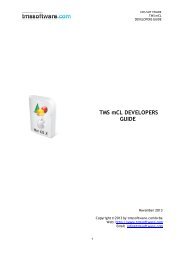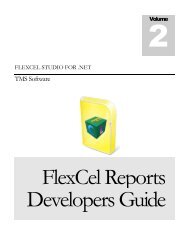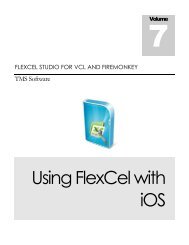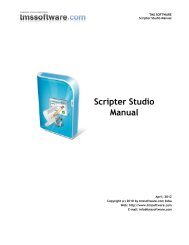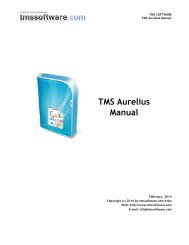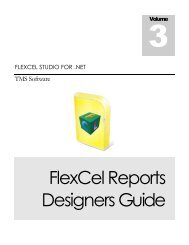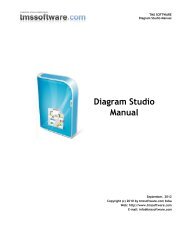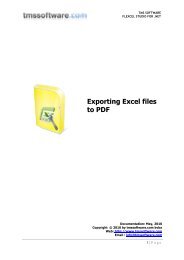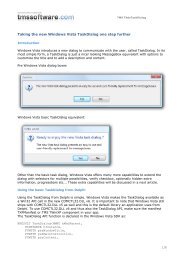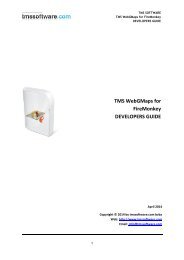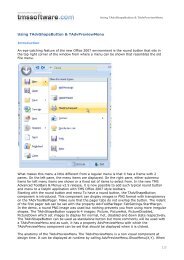Flexcel Reports Developers Guide - TMS Software
Flexcel Reports Developers Guide - TMS Software
Flexcel Reports Developers Guide - TMS Software
You also want an ePaper? Increase the reach of your titles
YUMPU automatically turns print PDFs into web optimized ePapers that Google loves.
<strong>TMS</strong> SOFTWARE<br />
FLEXCEL STUDIO FOR .NET<br />
About Excel Reporting<br />
FlexCel gives you two ways to create an Excel file, with XlsFile (API) or with FlexCelReport<br />
(Template).<br />
Each method has its good and bad things, and it is good to know the advantages and drawbacks of<br />
each.<br />
Creating a report using XlsFile is a low level approach; we might if you want compare it with<br />
programming on assembler. Assembler programs are fast and can use all the power on your<br />
machine. Also, assembler programs are difficult to maintain and difficult to understand to anyone<br />
who was not the author. And sometimes they are difficult to understand for the author too.<br />
Similar to assembler, creating a report with XlsFile will result on a really fast report, and you have<br />
access to the entire API, so you can do whatever you can do with FlexCelReport and more. After all,<br />
FlexCelReport uses XlsFile internally.<br />
And, again similar to assembler, XlsFile reports can be a nightmare to maintain. When you reach<br />
enough number of lines like:<br />
xls.SetCellValue(3,4,”Title”);<br />
XlsFormat.Font.Bold=true;<br />
XlsFormat.Font.Size=14;<br />
XF = xls.AddFormat(XlsFormat.);<br />
xls.SetCellFotmat(3,4, XF);<br />
Changing the report can become quite difficult. Imagine the user wants to insert a column with the<br />
expenses (And don't ask me why, users always want to insert a column). Now you should change the<br />
line:<br />
xls.SetCellFotmat(3,4, XF);<br />
to<br />
xlsSetCellFotmat(3,5, XF);<br />
But wait! You need to change also all references to column 5 to 6, from 6 to 7... If the report is<br />
complex enough, (for example you have a master detail) this will be no fun at all.<br />
But there is something much worse on using XlsFile directly. And this is that again, similar to<br />
assembler, only the author can change the report. If your user wants to change the logo to the new<br />
one, he needs to call you, and you need to recompile the application and send a new executable.<br />
FlexCelReport is a higher level approach. The design is cleanly separated on three different layers,<br />
data layer, interface layer and presentation layer, and most of the work is done on the presentation<br />
layer, with Excel. You design the report visually on Excel, and you mess as little as possible with the<br />
data layer. If the user wants to change the logo, he can just open the template and change the<br />
logo. If he wants to insert a column, he can just open the template and insert a column. And the<br />
application does not even need to be recompiled.<br />
As with any higher level approach, it is slower than using the API directly, and there are some things<br />
where it is more limited. But all in all, reports are really fast too and the things you cannot do are<br />
not probably worth doing anyway.<br />
So, the option is yours. For normal reports we highly recommend that you use FlexCelReport. Even<br />
when it can take a little more time at the beginning that just hurry and start coding, it will pay on<br />
the long run. And much.<br />
4 | P a g e



